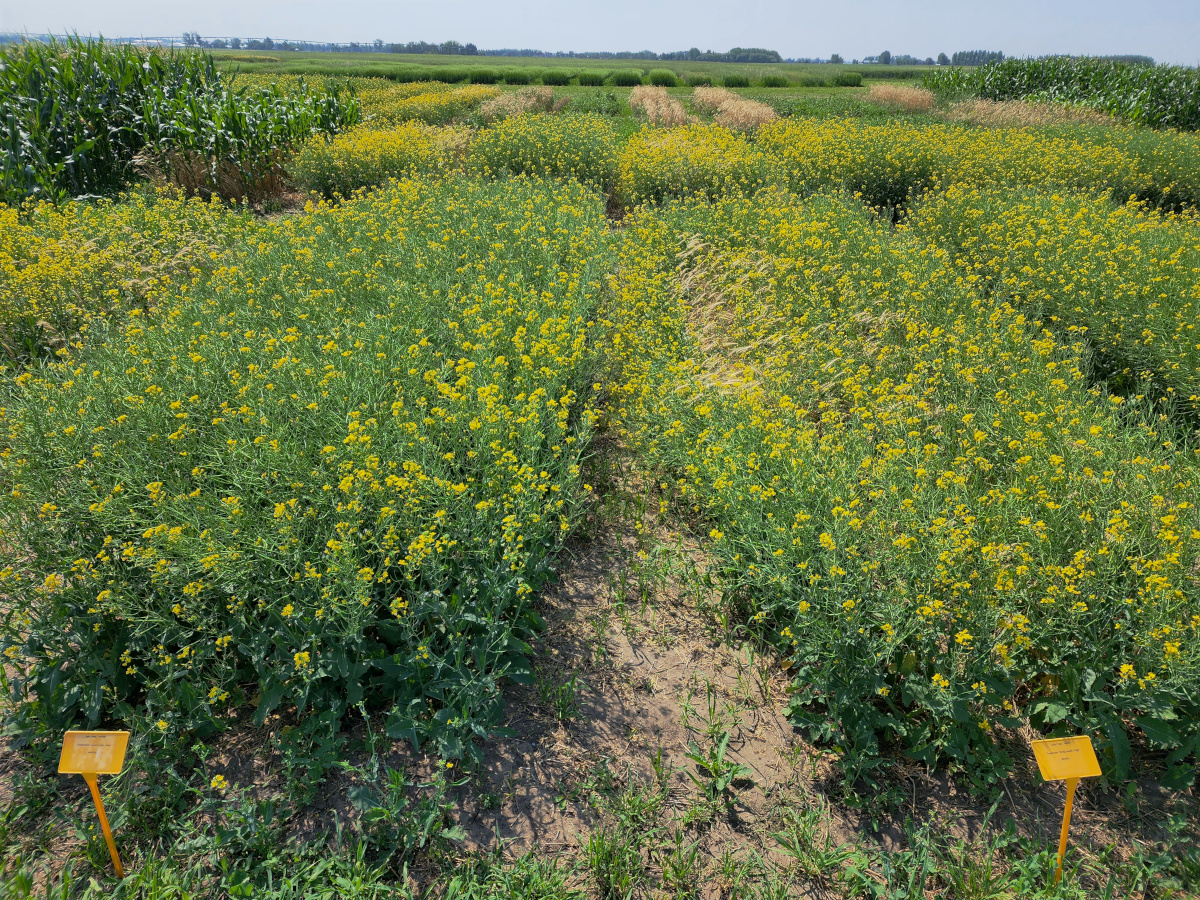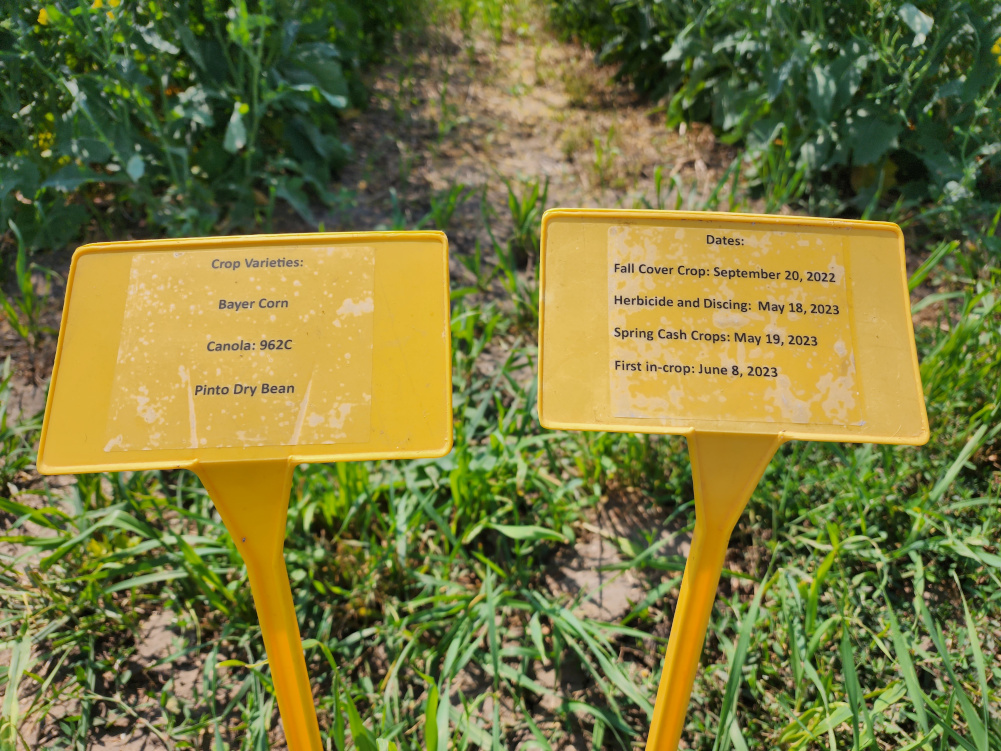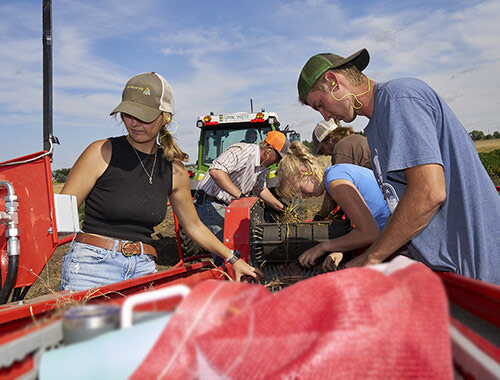Protecting your field and your crops
A terrible drought leaves your field exposed to the elements - if gusts of wind sweep away the dry soil, you’re only left with more bad luck. What starts as soil erosion in the fall becomes wind sheared crops in the spring. With no way to resist the throes of mother nature, you’re helpless as nature whittles down your field and your yields reduce year after year. However, one practice could prove a formidable defense in southern Alberta to the whims of nature.
The great speeds of Chinook Winds impose a formidable threat to farmers through soil erosion and wind shear. Inter-row cover crops could quell both the threat of erosion and the threat of herbicide resistant weeds in southern Alberta.
At the end of 2022, Farming Smarter received funding for intensive soil health research from the Weston Family Foundation and RBC’s Tech for Nature grant. With that funding, we kicked off two projects under the Saving Soils umbrella – our roller crimping and living mulch studies. While intercropping and in-row mulch have benefits, we don’t know the extent of those benefits here.
|
|
|
Image Caption: The cover crop living mulch trials at Farming Smarter. Rows of corn, canola, and dry beans were planted to see how well inter-row cover crops help the establishment of spring seeded cash crops, 2023. |
Regardless of how effective the system is, we can provide local growers with effective data . If the system works, they’ll have the know-how to adopt the practice. If it doesn’t, then they can save themselves the cost by letting us fail for them!
The idea behind living mulch is to keep organic matter in the field to reduce the chances of wind and water erosion. It also limits weed competition for the cash crop.
“Living mulch is the idea that we are crossing the green bridge,” says Mike Gretzinger, Agronomy Research Team Lead. “We leave living material between the rows in our crops, instead of harvesting them like intercropped systems.”
“The cover crop between the rows of the cash crop provides a living root. This helps improve soil structure and combat soil erosion, and potentially reduces wind shear,” says Gurbir Dhillon, Farming Smarter’s Research Scientist.
For this project, we’re researching the efficacy of retaining cover crops between main crop rows for the early growing season under irrigated systems. This project evaluates fall rye and winter peas with a variety of cash crops; this year we started with corn, canola, and dry beans. The first two are utilized in glyphosate resistant systems, which has led to some great results. However, the dry beans do not yet have a glyphosate-resistant cultivar. This has presented the challenge of terminating the cover crops after dry bean has emerged.
Each crop has two trials – one seeded in early September and the other in late September. Each trial has three treatments: planting ‘green’ into the standing cover crop with strip-tilling, terminating the cover crops prior to seeding with a herbicide spray, and an untreated check without cover crops. This allows us to identify the best method of cultivating the cover crop system in the field.
Additionally, each crop is seeded into a low density cover crop and a high density cover crop.
|
|
|
Image Caption: On the left, canola shows great establishment into a low density plot of fall rye. On the right, canola shows troubles with establishment when seeded into fall rye with a high density. |
“We’re seeing that the cover crops with the higher seeding rate are crowding out our cash crops. Meanwhile, the cover crops with the lower seeding rate aren’t causing problems with our spring seeded crops,” comments Gretzinger.
Our goal with the inclusion of the strip till trials is to improve the establishment of the cash crops. Not only does it provide warmer soils and improve the seed-to-soil contact, but it also removes the odds of our spring seeded crops to get tangled up with the established cover crops. Thus, we are comparing it with the no-till trials to see if there is any advantage to do it.
After the cash crop has established, we want to take advantage of the vital early stages and remove nutrient competition. During the 2-4 leaf phase of the cash crop, we apply herbicide to terminate the cover crops. Terminating the cover crops stops them from utilizing soil nutrients but still provides the initial benefits to our cash crops.
“Killing the inter-row cover crop allows the cash crop full access to the nutrients and moisture available in the soil. Yet, the cover crop stands tall even after it dies and continues to provide soil structure and snuff out weeds,” says Dhillon.
However, a possible detriment exists with a towering cover crop. Its height means shading beneath the canopy still occurs, which could have negative effects for the cash crop. If this proves to be the case, we have already had the idea of earlier herbicide applications.
|
|
|
Image Caption: Signs from our Plot Hop indicate the varieties of cash crops used in the study and our seeding and spraying dates. |
A still unknown risk is the effect this companion crop system has on nutrient and moisture availability within the soil. To track this data, we are using moisture probes, as well as Plant Root Simulator (PRS) probes, to study potential long-term effects. This will allow us to gauge an appropriate response, if needed, to include in the study in subsequent years.
We will review the yield, biomass, and any signs of competition after the conclusion of our first year. This information will give us an idea of how effective living mulch is in a cropping system. Additionally, it will let us know if we need to make any changes to improve the system.
We look forward to the winter when we can update you with results!
Mike Gretzinger Shows Off Living Mulch Cover Crops! |
|
|
|
Image Caption: In-between the rows of our dry beans, the fall rye has been terminated and provides organize material for the emerging crops. |







